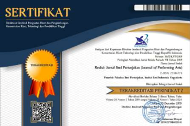Uji Coba Produk Lagu Anak-Anak Bertema Pendidikan
Abstract
Media ajar berupa nyanyian atau lagu dipandang sangat penting untuk membantu pencapaian tujuan pendidikan yang dilakukan dalam suatu proses belajar mengajar baik formal maupun nonformal. Salah satu media ajar yang dapat digunakan untuk membantu anak-anak prasekolah dalam memahami pesan pendidikan adalah lagu anak-anak. Tujuan pokok penelitian ini adalah menguji penciptaan lagu anak-anak dikaitkan dengan daya gunanya untuk menyampaikan pesan pendidikan. Metode yang digunakan dalam penelitian ini adalah metode terapan. Subjek penelitian adalah para guru prasekolah. Langkah uji dilakukan dengan mengambil cara yang paling sederhana, yakni pertama, memperdengarkan lagu. Kedua, menirukan lagu yang diperdengarkan dan disampaikan pesan lagu dalam bentuk nyanyian. Hasil penelitian menunjukkan bahwa para guru tampak tertarik dengan lagu yang diperdengarkan. Selain itu, guru dapat dengan mudah menirukan lagu yang diperdengarkan dan menangkap isi atau pesan lagu.
Learning material in a form of songs is considered essential to support educational purposes of a certain teaching and learning process in formal, non-formal, and informal educations. Children song is one of several types of learning material which is used to help students in understanding educational messages. The main aim of this study is to deeply examine the creation of children song and to confirm whether the children song creation has been in line with its usability− which is to deliver educational messages to children. Method implemented in this research was developmental research, while the research subjects were preschool teachers. Stages in trying out the songs to the research subjects comprised three steps. First, subjects listened to the songs. Second, subjects imitated the songs and captured the meaning behind it. Third, subjects understood and analyzed the songs. Results showed that the teachers, first, were interested to the songs. Second, teachers found no difficulties in imitating the songs. Lastly, teachers were able to easily understand the message delivered through the songs.
Keywords
Full Text:
PDFReferences
Caine, R. N., & Caine, G. (1991). Teaching and The Human Brain. Alexandria: Association for Supervision and Curriculum Development.
Chernets, V. (2010). ARTS AND AESTHETICS : NATURE AND THE SPECIFIC RELATIONSHIP AND INTERACTION. Interdisciplinary Approach to Economics and Sociology, 3(2), 114–120.
Ehrlin, A., & Gustavsson, H.-O. (2015). The Importance of Music in Preschool Education. Australian Journal of Teacher Education, 40(7), 32–42.
Fitriani, Y. (2014). Model Pembelajaran Seni Musik melalui Lesson Study: Studi Kasus di SD Jawilan Serang. Resital, 15(2), 126–138.
Jacobsen, D. A., Eggen, P., & Kauchak, D. (2009). Methods for Teaching (8th ed.). Boston: Pearson Education.
Keesing, R. M. (1990). Theories of culture revisited. Canberra Anthropology, 13(2), 46–60.
Kementrian Pendidikan dan Kebudayaan. (2015). MENTERI PENDIDIKAN DAN KEBUDAYAAN REPUBLIK INDONESIA NOMOR 146 TAHUN 2014 TENTANG KURIKULUM 2013 PENDIDIKAN ANAK USIA DINI.
Kemp, R. (2003). AESTHETIC PERSPECTIVALISM AND THE NATURE OF ART : TWO PROPOSALS ATTEMPTING TO DEVELOP A THEOLOGY OF THE ARTS. IIIM Magazine Online, 5(22), 1–11.
Rahim, M. A. (2009). Seni dalam Antropologi Seni. Imaji, 5(2), 44–55.
Raj, S. J., & Muniapan, B. (2012). MUSIC , SONG LYRICS , PHILOSOPHY AND HUMAN VALUES : EXPLORING POET KANNADASAN ’ S CONTRIBUTIONS TO. International Refereed Research Journal, 3(4 (2)), 1–12.
Richey, R. C., & Klein, J. D. (2005). Developmental Research Methods: Creating Knowledge from Instructional Design and Development Practice. Journal of Computing in Higher Education, 16(2), 23–38.
Ritchey, T. (1991). Analysis and Synthesis On Scientific Method - Based on a Study by Bernhard Riemann. System Research, 8(4), 21–41.
Rosmiati, A. (2014). Teknik Stimulasi dalam Pendidikan Karakter Anak Usia Dini melalui Lirik Lagu Dolanan. Resital, 15(1), 71–82.
Ryan, T. G., & Brown, K. (2012). Musical Creativity : Measures and Learning. Journal of Elementary Education, 22(2), 105–120.
Supradewi, R. (2010). OTAK , MUSIK , DAN PROSES BELAJAR. Buletin Psikologi, 18(2), 58–68.
Supriyanti, S., & Suharto, D. (2015). Penciptaan Tari Manggala Kridha sebagai Media Pembentukan Karakter bagi Anak. Journal of Urban Society’s Arts, 2(1), 18–24.
Tyasrinestu, F. (2014). Lirik Musikal pada Lagu Anak Berbahasa Indonesia. Resital, 15(2), 163–168.
Wadiyo, W. (2015). MUSIC AS AN INTEGRATED EDUCATION TOOL FOR PRESCHOOL STUDENTS. Harmonia: Journal of Arts Research and Education, 15(2), 144–151. https://doi.org/10.15294/harmonia.v15i2.4691
Wright, C. (2011). Listening to Music (6th ed.). Boston: Schirmer.
Youm, H. K. (2013). Parents â€TM Goals , Knowledge , Practices, and Needs Regarding Music Education for Their Young Children in South Korea. MENC: The National Association for Music Education, 61(3), 280–302. https://doi.org/10.1177/0022429413497233
Zeki, S. (2013). Clive Bell ’ s “ Significant Form ” and the neurobiology of aesthetics. Frontiers in Human Neuroscience, 7(November), 1–14. https://doi.org/10.3389/fnhum.2013.00730
DOI: https://doi.org/10.24821/resital.v17i3.2226
Refbacks
- There are currently no refbacks.
This work is licensed under a Creative Commons Attribution 4.0 International License.



